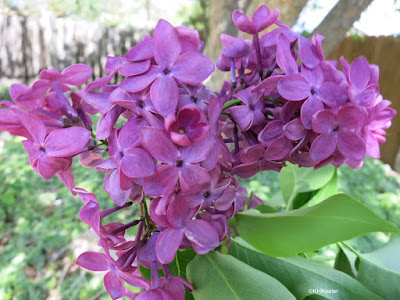The word lilac is derived from a word for blue, though the experts don’t agree quite which language started it. You can read that it comes from Persian and Spanish but those are far from the native range of lilacs so likely not the source. Geographically, lilac is likely from a Balkan language, Albanian for example, but I have found no clear linguistic argument. Since lilac is a color word in English, it has come full circle: the plant was called lilac describing the flower colors and then in other languages, the name of the plant, lilac, became the name of a color.
The Syringa part of lilac’s scientific name, Syringa vulgaris, is based on syringa, the Greek word for pan pipes. Pan pipes were made by cutting hollow twigs or reeds into different lengths and attaching them side-by-side. The instrument was played by and named after the Roman god of shepherds and hunters, Pan. In Europe, lilac's hollow stems were often used for making pan pipes. The second part of the scientific name, vulgaris, is Latin for “common,” meaning “ordinary” rather than “coarse and rude.” (You can seem how the meaning has shifted in English). Lilac's role making pan pipes seems to have been lost in North America: time to try it.
Blue-purple lilacs came to North America with some of the earliest colonists. George Washington planted many lilac bushes at Mount Vernon. Lilacs at the Governor Wentworth estate in Portsmouth, New Hampshire are believed to be the oldest living lilacs in North America, planted in 1750. Lilacs went west with the settlers, and big old plants from the late 1800s can be found at old ranch houses across the Plains. White and deep purple varieties were developed about that time. Double flowers are more recent. Plant breeders then imported smaller species of lilac from Asia and hybridized them, making the dozens of interesting sizes and colors available today.
One lilac plant will give you a clump. The plants spread from rhizomes (underground stems). My neighbor has a row of lilacs on his side of the fence between our properties. The lilacs keep coming up on my side. Without having to shop or dig, I’m developing a very nice row of lilacs on my side of the fence.
Lilacs are cool-climate plants that require a period of being dormant due to cold temperatures in order to set flower buds. What that means is they flower poorly or not at all in places with warm winters. Apples are another cool-climate plant. People like me who live with severe winters tend to envy gardeners in the South and West for the plants that they can grow and we can’t, oranges and palms for example. Lilacs and apples are the reverse, plants that grow well for us and not in milder climates.
Lilac flowers are edible. They don’t taste like much, although the sweet scent lingers. Traditionally they were cooked as fritters or candied. Much more simply, they are absolutely gorgeous as a garnish.
Lilacs have of course picked up folklore. Russians hung them over the baby’s bed, for wisdom. In the Victorian England, lilac flowers signified old loves and for that reason were often worn by widows. They were thought to drive away evil and in New England were planted for that purpose. Curiously the English thought it bad luck to bring lilac flowers into the house, while American folklore said that fresh lilac flowers put in a haunted house would drive out the ghosts.
Each time I look at the photos of lilacs, I am reminded of their lovely scent. Since I can't transmit that to you over the internet, be sure to stop and smell the lilacs at the first opportunity.
Comments and corrections welcome.
Comments and corrections welcome.
References
Arnold Arboretum. Lilacs. link Accessed April 27, 2017.
Cunningham, S. 1985. Cunningham's encyclopedia of magical herbs. Llewellyn Publications, St. Paul, Minnesota.
Friends of the Farm. History of the lilac. Central Experimental Farm, Ottowa, Canada. link Accessed April 27, 2017.
Ftd.com. 2016. Lilacs meaning and symbolism. link Accessed April 27, 2017.
Missouri Botanic Garden Plant Finder. Syringia vulgaris 'sensation' link Accessed April 27, 2017.
Reilly, A. 1961.Taylor's pocket guide to herbs and edible flowers. Chanticleer Press Edition, Houghton Mifflin, New York.
Cunningham, S. 1985. Cunningham's encyclopedia of magical herbs. Llewellyn Publications, St. Paul, Minnesota.
Friends of the Farm. History of the lilac. Central Experimental Farm, Ottowa, Canada. link Accessed April 27, 2017.
Ftd.com. 2016. Lilacs meaning and symbolism. link Accessed April 27, 2017.
Missouri Botanic Garden Plant Finder. Syringia vulgaris 'sensation' link Accessed April 27, 2017.
Reilly, A. 1961.Taylor's pocket guide to herbs and edible flowers. Chanticleer Press Edition, Houghton Mifflin, New York.
Vickery, R. 1995. Oxford dictionary of plant-lore. Oxford University Press, Oxford, England.
Kathy Keeler, A Wandering Botanist
More at awanderingbotanist.com





No comments:
Post a Comment